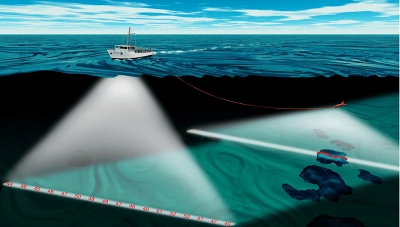
|
Ocean floors are mapped using sound equipment and robot submarines. Sonar systems send out high -frequency pulses. The time it takes for the sound pulse to echo back from the ocean floor gives an idea as to the depth of the ocean. |
Understanding the depth and shape of the seafloor, called bathymetry, is not only a mapping challenge but it is important if we are to better understand are oceans. This includes understanding ocean circulation, which affects climate, tsunamis, environmental change, underwater geo-hazards, resources, and many other processes affecting the environment, safety, and commerce.
Mapping the seafloor has been occurring since the early 19th century; however, obtaining accurate data has been a challenge until the invention of the sonar. More recent sonars (short fo Sound Navigation and Ranging) provide far more accurate data, particularly when multibeam echosounder sonars are used.
The Seabed 2030 project is a project attempting to map the seafloor by 2030. Until now, however, only about 20% of the seafloor has been mapped using modern bathymetry methods. In part, the project to map the seafloor will benefit from crowd sourced data obtained from various ocean-going vessels.
However, NOAA is also leading the effort and vessels with sonar equipment are being used to map regions not often travelled by vessels. These vessels are equipped with the latest multibeam sonars that provide hydrographic surveying results that can then build detailed maps with about 0.5 meter resolution.
The mapping efforts are attempting to use different frequencies, from around 12 kHz to closer to 200 kHz, often used in shallower waters. While generally deeper sea levels are easier to map, as sound waves travel and allow a wider region to be surveyed as a ship passes by, shallow areas present challenges, given that multiple passes need to cover less area and interference observed from other sea life and vessels can disrupt data.
Credit: GIS LOUNGE
Picture Credit : Google




